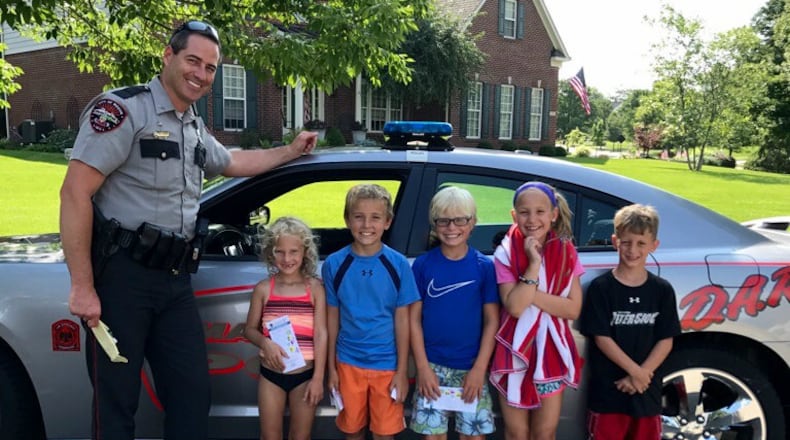Since the program started, Mason officers have been issuing a “Good Choice Ticket” to children and teenagers in the community for demonstrating good citizenship. In return, recipients can present their ticket to one of the five participating sponsors of the program — the Mason Police Department, Mason Community Center, the City of Mason Golf Center, Culver’s Restaurant and Jansen’s Sweet Sinsations Bakery and receive a special treat.
Ketterer said issuing a Good Choice Ticket provides the opportunity for Mason Police Officers to interact with the younger members of the community and it also gives children the opportunity to engage in a positive and rewarding interaction with local law enforcement. He said 288 Good Choice Tickets have been issued to date. The program will run through Sept. 4, and tickets must be redeemed for rewards by Oct. 1.
Q: Tell us about yourself and your role within the Mason Police Department.
A: I've been an officer on the Mason Police Department for 15 years. Currently I'm assigned to our schools, which is part of our Services Division. I teach there during the school year. During non-school breaks and summer, I work within our Services Department, which includes community service programs, and any other assistance that the department needs.
Q: What does your position at the schools involve?
A: I'm a school resource officer. We have two school resource officers in Mason. One is Officer Karli Dyer, she handles Mason High School. Then, I handle the Mason Intermediate School, which is the fourth-, fifth- and sixth-grade building. My job is to teach D.A.R.E. curriculum to sixth-grade students. Traditionally, I do mentoring for all of the schools for any counselors that think students within their buildings might benefit from a mentor. I participate in that with our elementary schools up through middle school.
Q: Why do you believe in the power of mentoring and why is it important for youth?
A: I've been serving in the schools for three years. This is my third year. One thing I've learned, or come to appreciate in the schools, is that a lot of kids have difficult backgrounds, and having a mentor, especially one that's in a position where they can be a role model, is valuable. So, I enjoy that, because obviously, it requires no money or lengthy amount of work to sit down and be someone's friend. There's tremendous value in that. A lot of kids, especially middle school and younger, look up to police officers. I'm blessed to have that role.
Q: Why did you want to be a Mason police officer?
A: I grew up in Montgomery. So, I'm from the Greater Cincinnati area. Mason was hiring in 2001 when I applied. I was familiar with the city, because I had friends that lived here. I liked the city. It was one of the few places I applied at in 2001, and I was lucky enough to be hired on here. I've been working as a police officer in Mason since late 2002.
Q: How did your background prepare you to become a police officer?
A: I come from a family of six. I have two older brothers and a younger sister. We're a pretty close family. Growing up, I was always concerned about other people. I always cared about doing the right thing and being honest and having those kinds of values and morals. As I became a teenager, law enforcement and fire-fighting were my only interests. Eventually, I became more interested in law enforcement, and that's the path I took through my teenage years to college and into adulthood. I enjoy helping people and having an influence any way I can within the community where I live, or where I work. It's always been a value or a goal of mine.
Q: Can you give us a couple of examples of how youth have been recognized through the Good Choices Youth Recognition Program?
A: Most of them are for playing outdoors, or being well mannered inside a facility, saying "please" and "thank you" and wearing bicycle helmets. Except for maybe one or two categories like roller blading or riding scooters, all of the categories have been observed. For example, our traffic officers are noticing that youth are using the crosswalks a lot more, or looking both ways before they cross the street. The shift officers notice children playing outdoors, because they patrol neighborhoods, and they see kids in their front yards or at the park. They pull up to the park, walk up and engage with children and their families, so they see a lot related to playing outdoors and greeting a police officer, which on a lot of occasions, kids will walk up to us and say "Hi." That's a pretty big deal, so we reward that, as well.
Q: How did the idea for the program originate?
A: Our police chief, Todd Carter, came up with the idea. I think he learned about it from other departments that are doing similar programs. Basically, he wants us to reward young people, juveniles and youth for good behavior. The goal is to reach out to youth, teenagers and younger children. He wants us to engage with the youth, introduce ourselves and soften the intimidation between a policeman or a policewomen, the uniform and the public.
Q: What difference does this make in their lives?
A: When I was young, I would keep things that were important to me. What happens with this is that after they redeem their ticket, they will keep it as a souvenir, and when they are older, they will look back on it and think it was pretty neat. It reinforces that they were recognized for doing something good. There's also value in meeting a police officer you typically wouldn't have an opportunity to meet.
Contact this contributing writer at gmwriteon@aol.com.
About the Author
